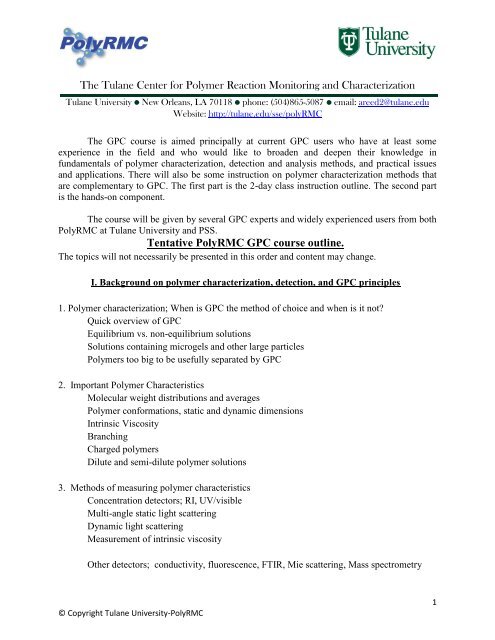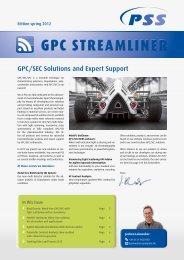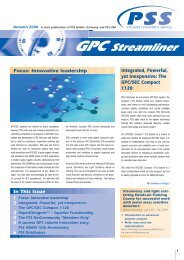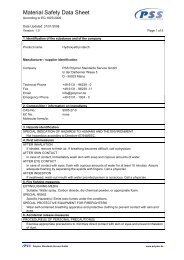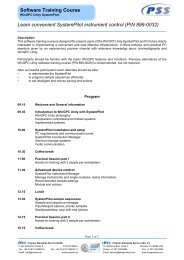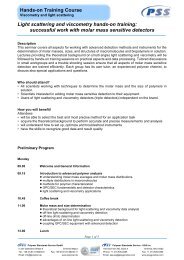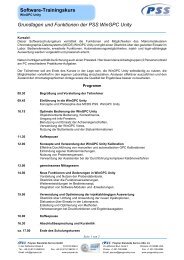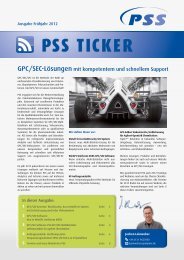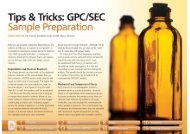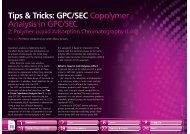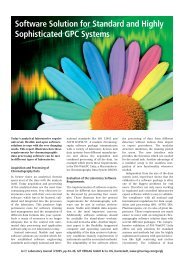The Tulane Center for Polymer Reaction Monitoring and ... - PSS
The Tulane Center for Polymer Reaction Monitoring and ... - PSS
The Tulane Center for Polymer Reaction Monitoring and ... - PSS
You also want an ePaper? Increase the reach of your titles
YUMPU automatically turns print PDFs into web optimized ePapers that Google loves.
<strong>The</strong> <strong>Tulane</strong> <strong>Center</strong> <strong>for</strong> <strong>Polymer</strong> <strong>Reaction</strong> <strong>Monitoring</strong> <strong>and</strong> Characterization<br />
<strong>Tulane</strong> University New Orleans, LA 70118 phone: (504)865-5087 email: areed2@tulane.edu<br />
Website: http://tulane.edu/sse/polyRMC<br />
<strong>The</strong> GPC course is aimed principally at current GPC users who have at least some<br />
experience in the field <strong>and</strong> who would like to broaden <strong>and</strong> deepen their knowledge in<br />
fundamentals of polymer characterization, detection <strong>and</strong> analysis methods, <strong>and</strong> practical issues<br />
<strong>and</strong> applications. <strong>The</strong>re will also be some instruction on polymer characterization methods that<br />
are complementary to GPC. <strong>The</strong> first part is the 2-day class instruction outline. <strong>The</strong> second part<br />
is the h<strong>and</strong>s-on component.<br />
<strong>The</strong> course will be given by several GPC experts <strong>and</strong> widely experienced users from both<br />
PolyRMC at <strong>Tulane</strong> University <strong>and</strong> <strong>PSS</strong>.<br />
Tentative PolyRMC GPC course outline.<br />
<strong>The</strong> topics will not necessarily be presented in this order <strong>and</strong> content may change.<br />
I. Background on polymer characterization, detection, <strong>and</strong> GPC principles<br />
1. <strong>Polymer</strong> characterization; When is GPC the method of choice <strong>and</strong> when is it not?<br />
Quick overview of GPC<br />
Equilibrium vs. non-equilibrium solutions<br />
Solutions containing microgels <strong>and</strong> other large particles<br />
<strong>Polymer</strong>s too big to be usefully separated by GPC<br />
2. Important <strong>Polymer</strong> Characteristics<br />
Molecular weight distributions <strong>and</strong> averages<br />
<strong>Polymer</strong> con<strong>for</strong>mations, static <strong>and</strong> dynamic dimensions<br />
Intrinsic Viscosity<br />
Branching<br />
Charged polymers<br />
Dilute <strong>and</strong> semi-dilute polymer solutions<br />
3. Methods of measuring polymer characteristics<br />
Concentration detectors; RI, UV/visible<br />
Multi-angle static light scattering<br />
Dynamic light scattering<br />
Measurement of intrinsic viscosity<br />
Other detectors; conductivity, fluorescence, FTIR, Mie scattering, Mass spectrometry<br />
© Copyright <strong>Tulane</strong> University-PolyRMC<br />
1
4. Physical principles of GPC (SEC) separation.<br />
II. Practical Aspects <strong>and</strong> Issues in GPC<br />
5. GPC columns<br />
* Column packing types <strong>and</strong> technologies<br />
* Practical aspects on column resolution<br />
* Column selection, use of multiple columns<br />
* Solvents <strong>and</strong> other considerations<br />
Multi-detector GPC demonstration I. (Topic TBA)<br />
6. Obtaining molecular weight distributions from GPC data<br />
* Column calibration using molecular weight st<strong>and</strong>ards <strong>and</strong> a concentration detector<br />
* ‘Universal calibration’ using a concentration detector <strong>and</strong> either a known viscositymass<br />
(Mark Houwink) relationship or a viscometer<br />
* Light scattering detection, ‘calibration-free’ GPC.<br />
* Comparison of the three methods, strengths <strong>and</strong> weaknesses of each, value of<br />
combining <strong>and</strong> comparing results of the different methods.<br />
7. Practical aspects of detectors <strong>and</strong> instruments, pros <strong>and</strong> cons:<br />
* Refractometers, determining dn/dc<br />
* single, dual wavelength, <strong>and</strong> diode array spectrophotometers<br />
* single capillary <strong>and</strong> bridge viscometers<br />
* single <strong>and</strong> multiple angle static light scattering<br />
* Pumps, autosamplers, autoinjectors, degassers, <strong>and</strong> other hardware.<br />
III. Special topics <strong>and</strong> applications in GPC (to be determined)<br />
<strong>The</strong> following are possible topics, which can be omitted <strong>and</strong> added according to participant<br />
preferences. Please fill out the questionnaire!<br />
GPC of polyelectrolytes<br />
GPC of natural products<br />
Topics in aqueous GPC<br />
Error analysis in GPC<br />
High Temperature GPC<br />
Branching characterization using mutli-detector GPC<br />
GPC of specific products; polysaccharides, proteins, polyolefins, elastomers,<br />
polyurethanes, additives<br />
© Copyright <strong>Tulane</strong> University-PolyRMC<br />
2
High molecular weight polymers<br />
Multi-detector GPC Demonstration II. (Topic TBA)<br />
<br />
<br />
<br />
IV. Complementary <strong>and</strong> alternative methods to GPC<br />
Automatic Continuous Mixing (ACM); Determining characteristics of multicomponent<br />
polymer systems, polymer solutions not amenable to GPC, measuring<br />
important auxiliary characteristics, measuring polymer dissolution kinetics.<br />
High throughput methods.<br />
Automatic Continuous Online <strong>Monitoring</strong> of <strong>Polymer</strong>ization reactions (ACOMP).<br />
GPC course outline h<strong>and</strong>s-on outline<br />
<strong>The</strong> h<strong>and</strong>s on component of the course will focus on data analysis <strong>and</strong> interpretation, <strong>and</strong> will<br />
also include practice in sample preparation <strong>and</strong> running GPC. Attendees will learn to distinguish<br />
good data from bad, spot frequent GPC problems (e.g. overloaded columns, limits of column<br />
resolution), encounter different scenarios (e.g. narrow, broad <strong>and</strong> multimodal polymer<br />
distributions), <strong>and</strong> fully analyze data by three distinct methods; i) column calibration by polymer<br />
st<strong>and</strong>ards, ii) universal calibration using viscosity detection, <strong>and</strong> iii) absolute molecular weight<br />
determination by light scattering. <strong>The</strong> training is general <strong>and</strong> applicable to any type of modern<br />
GPC apparatus. To facilitate the training, ParSEC software from Brookhaven Instruments <strong>and</strong>/or<br />
other software will be used, <strong>and</strong> each attendee will have access to a computer with this software<br />
in order to carry out all of the exercises. In addition to the intensive data analysis <strong>and</strong><br />
interpretation portion, PolyRMC personnel will demonstrate GPC procedures <strong>and</strong> attendees will<br />
prepare <strong>and</strong> inject ‘mystery samples’ on their own, with their subsequent data analysis being<br />
graded against the samples’ known characteristics.<br />
I. GPC experimental procedure demonstrations<br />
II.<br />
III.<br />
IV.<br />
Data analysis <strong>and</strong> interpretation demonstrations<br />
Portions III <strong>and</strong> IV are ‘self-paced’ <strong>and</strong> concurrent, with course instructors<br />
available <strong>for</strong> questions <strong>and</strong> help<br />
Attendee data analysis of various GPC scenarios<br />
© Copyright <strong>Tulane</strong> University-PolyRMC<br />
3


